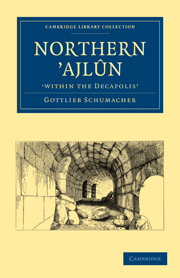Summary
THE DISTRICT OR NÂHIYET EL-KEFARÂT
The Nâhiyet el-Kefarât is bounded on the northwest and west by the Shari'at el-Menâdireh, or Yarmûk; on the south by the Nâhiyet es-Siru and the Wâd el-Humra. Its northern and eastern boundaries lie outside the limits of the present Map; they are formed in part by the District of As Siru, but for the greater distance by the Wâd esh-Shelâleh and the Haurân Province.
The country consists of a plateau, covered in most places by oak forests, and remarkable for its fertile soil, in which it resembles the Haurân plain. Its name recalls the Greek designation of “the Decapolis,” for El-Kefarât means the “ruined sites,” or “the Villages.”
Villages, Ruins, &c., as far as explored.
Arâk el-Heitalîyeh.—A perpendicular precipice of limestone rock, formed by a landslip, bordering the Yarmûk. From the many similar landslips of this vicinity, the Yarmûk Valley in these parts presents an extremely picturesque aspect.
Akhfas el-Heitalîyeh.—A round hill; a portion of the above-mentioned ʾArâk. Over it are scattered building stones, probably fallen down from the site above.
ʾArakîb el-ʾEslishi.—Also a portion of the abovenamed ʾArâk. It is a steep slope, west of Khirbet el-Heitalîyeh.
ʾAin Samar.—A copious spring belonging to the village of Samar.
- Type
- Chapter
- Information
- Northern ’Ajlûn, 'within the Decapolis' , pp. 114 - 118Publisher: Cambridge University PressPrint publication year: 2010First published in: 1890

